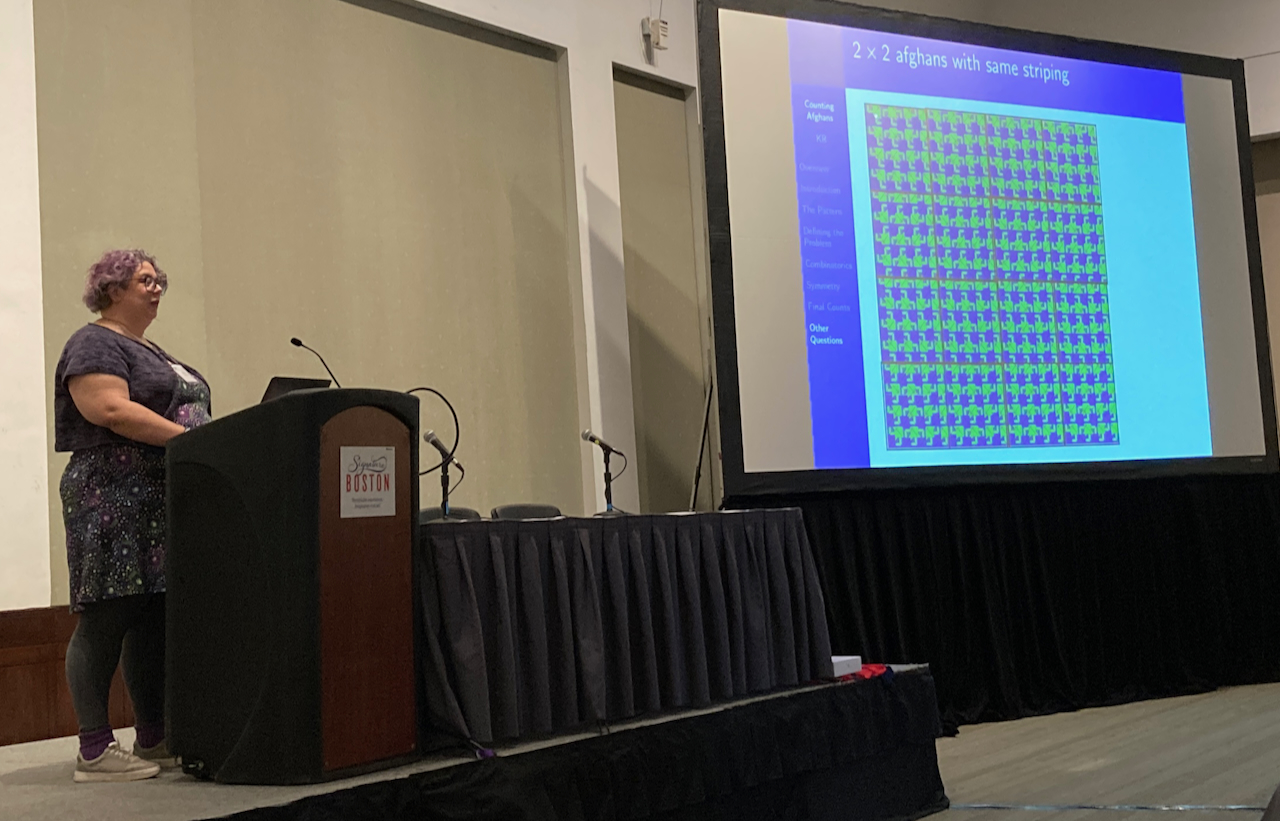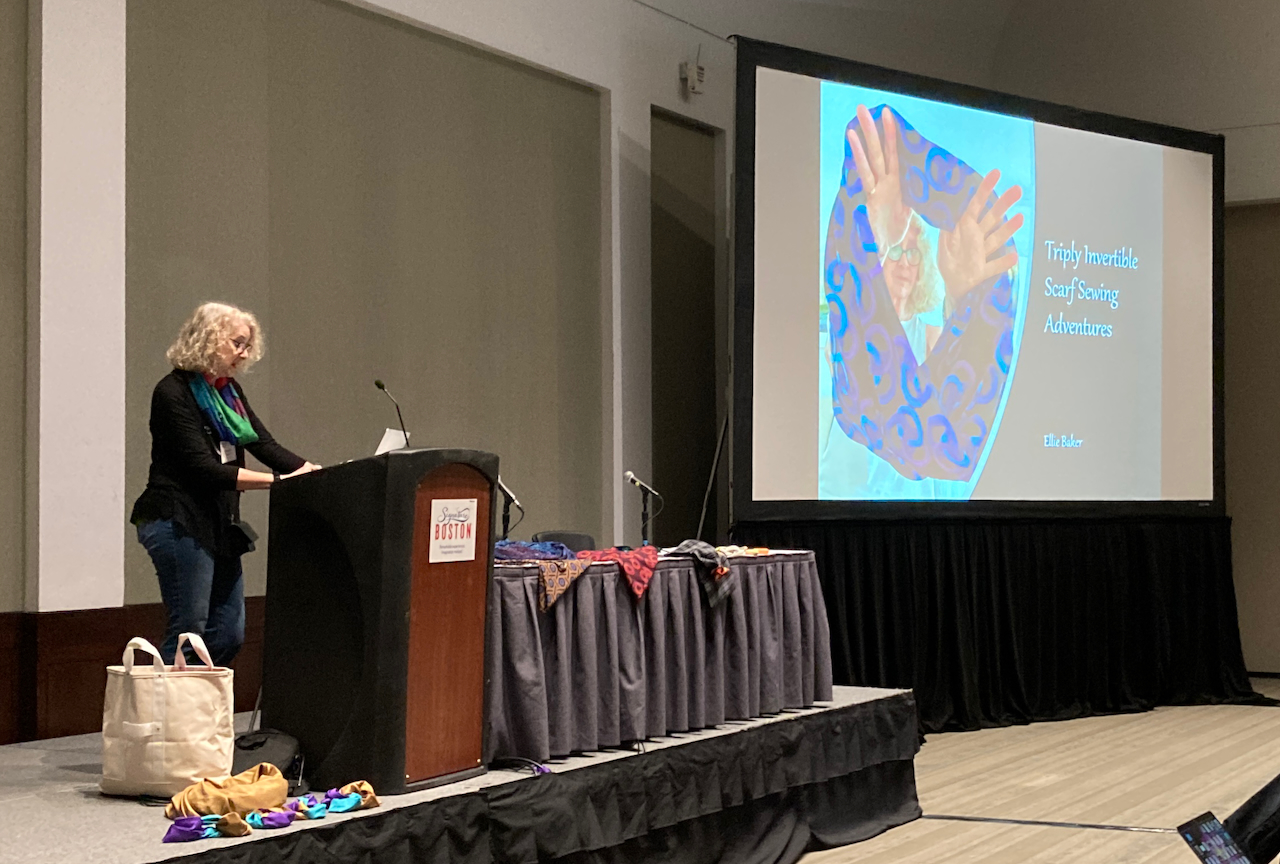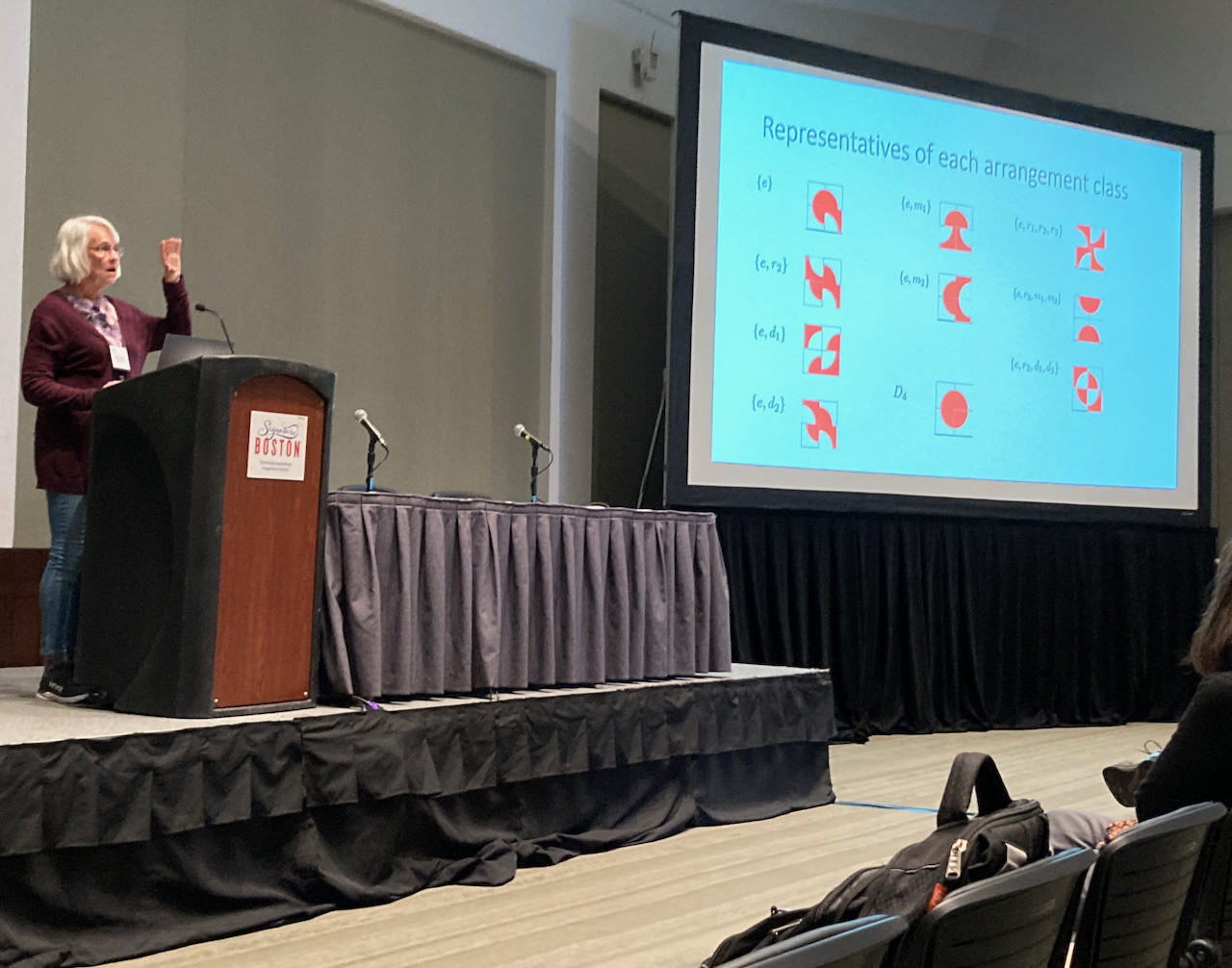Home page for the
2023 AMS Special Session on Mathematics and Fiber Arts
which took place at the Joint
Mathematics Meetings in Boston, MA, on Wednesday, January 4, 2023,
8:30 a.m.--12:00 noon and 1:30 p.m.--6:00 p.m.
Organizers: Carolyn Yackel
and sarah-marie belcastro.
This is the fourth AMS Special Session in the field: here are the pages for
the 2005, 2009, and 2014
Special Sessions.
We again hosted a juried exhibition of fiber
arts pieces accompanying the Special Session (photos here), and as usual we hosted the Knitting
Circle (Thursday January 5, 8:15--9:45, photos here).
Schedule:
Each talk was 20 minutes long, with 10 minutes for questions and
travel between sessions. Photos of speakers in action accompany the abstracts below.

8:30: Ellie Baker, on Triply Invertible Scarf Sewing Adventures
9:00: Carolyn Yackel (Mercer University), on Stitching Catalan Temari
9:30: Shiying Dong, on A Singular Technique For Seamless Crochet Surfaces
10:00: sarah-marie belcastro, on Curvature Within Knitted Blanket Squares
10:30: Heather Ames Lewis (Nazareth College), on Folding Granny
11:00: Elizabeth Wilmer (Oberlin College), on Knitting Origami
11:30: Mary D. Shepherd, on A Look At Symmetry And Two-Color Symmetry Patterns Involving The Drunkard's Path Quilt Tile
(break for lunch and such)
1:30: Berit Givens (Cal Poly Pomona), on The Trinomial Coefficients In A Knit Shawl Pattern
2:00: Kim Roth (Juniata College), on A Mathematician Knits An Afghan. How Many Hue Shifts?
2:30: Sara Jensen (Carthage College), on On The Number Of Sequence Knitting Patterns
3:00: Joshua Holden (Rose-Hulman Institute of Technology), on Monsters In The Hollow: Counting Naiki Braid Patterns Using De Bruijn's Monster Theorem
3:30--4:30 Exhibit time! Photos.
4:30: Rebecca Field (James Madison University), on Crackling Dynamics In Mechanical Response Of Various Knit Materials: Preliminary Report
5:00: Sabetta Matsumoto (Georgia Tech), on Twisted Topological Tangles Or: The Knot Theory Of Knitting
5:30: Susan Goldstine (St. Mary's College of Maryland), on Branch And Twist: Mathematics In Two-Color Brioche Knitting
Abstracts
Carolyn Yackel: Stitching Catalan Temari
The purpose of this talk is to discuss the mathematics relevant to depicting the thirteen Catalan solids on spheres via the medium of temari, an art form of embroidering on thread wrapped balls. Relevant issues pertain to polyhedral vertex point plotting on real-world spheres and analyses of specific ornamentation strategies using spherical geometry, combinatorics, and athestics.

Shiying Dong: A Singular Technique For Seamless Crochet Surfaces
Traditional crochet techniques construct textile surfaces by first creating patches with simple topology and combining them along one-dimensional seams. In this talk, a new technique for crocheting general surfaces from singular skeletons will be described. For any surface, the nontrivial topology is encoded in the foundation building step, where twisted chains form a graph onto which the final surface possibly minus finite points retracts. This technique is extremely powerful to generate possibly unorientable Seifert surfaces of links and knots, for which the recipe of generating the initial twisted chain graphs will be shown. Explicit examples including Seifert surfaces of Borromean rings and other alternating links, torus knots and torus links will be demonstrated. Additionally, a possible direction where this technique can be used to generate non-manifold spaces will be discussed with examples.

Sara Jensen: On The Number Of Sequence Knitting Patterns
Sequence knitting is a type of knitting that comes from a straightforward directive; determine a short basic sequence of stitches and create a garment by continuous repetition of that sequence. This talk investigates the question of how many different sequence knitting patterns there are. Many variables influence the answer to this question, including the number/types of stitches that are allowed in the sequence, the length of the sequence, whether or not one is knitting in the round, and whether or not one continues the sequence at the end of a row. We focus mainly on sequence knitting patterns that use only the knit and purl stitches and are knit on straight needles. Topics that appear in this sequence knitting work include combinatorial necklaces, group actions, and chirality. Skill or knowledge of knitting is neither assumed nor necessary to understand this talk.

Kim Roth: A Mathematician Knits An Afghan. How Many Hue Shifts?
While knitting a Hue Shift afghan, I began to wonder, how many possible afghans of this type are there? This led to more questions. What makes an afghan a Hue Shift? What should we count and how? These questions will be answered and other questions will be asked.

Elizabeth Wilmer: Knitting Origami
I will present techniques for embedding horizontal, vertical, and 45-degree diagonal crease lines into garter stitch knitted fabric and discuss how they were developed. While these techniques are mostly based on standard knitting stitches, horizontal creases required novel methods. This crease library suffices to knit a model of a square twist, a foundational origami tessellation unit.

sarah-marie belcastro: Curvature Within Knitted Blanket Squares
Shaping of knit fabric is accomplished by placement of increases, decreases, and short rows. Over an area, these allow us to change the relative row/stitch lengths in principal directions so as to induce curvature. Essentially any desired uniform or nonuniform curvature can be achieved in this manner. However, the situation is different for knitted blanket squares because they have fixed boundary and so the possibilities are constrained by invariants from differential topology. We will use the above-described constellation of ideas to explore constructions for knitting blanket squares with curved interiors.
Sabetta Matsumoto: Twisted Topological Tangles Or: The Knot Theory Of Knitting
Imagine a 1D curve, then use it to fill a 2D manifold that covers an arbitrary 3D object---this computationally intensive materials challenge has been realized in the ancient technology known as knitting. This process for making functional materials 2D materials from 1D portable cloth dates back to prehistory, with the oldest known examples dating from the 11th century CE. Knitted textiles are ubiquitous as they are easy and cheap to create, lightweight, portable, flexible and stretchy. As with many functional materials, the key to knitting's extraordinary properties lies in its microstructure.
At the 1D level, knits are composed of an interlocking series of slip knots. At the most basic level there is only one manipulation that creates a knitted stitch---pulling a loop of yarn through another loop. However, there exist hundreds of books with thousands of patterns of stitches with seemingly unbounded complexity.
The topology of knitted stitches has a profound impact on the geometry and elasticity of the resulting fabric. We have developed a formalization of the topology of two-periodic weft knitted textiles using a construction we call the swatch [1]. Using this construction, we can prove that all two-periodic weft knits form ribbon links [2]. This puts a new spin on additive manufacturing---not only can stitch pattern control the local and global geometry of a textile, but the creation process encodes mechanical properties within the material itself. Unlike standard additive manufacturing techniques, the innate properties of the yarn and the stitch microstructure has a direct effect on the global geometric and mechanical outcome of knitted fabrics.
The authors were partially supported by National Science Foundation grant DMR-1847172 and by the Research Corporation for Science Advancement. We would like to thank sarah-marie belcastro, Jen Hom, Jim McCann, Agniva Roy, Saul Schleimer and Henry Segerman for many fruitful conversations.
[1] S. Markande and S. Matsumoto, in: Proceedings of Bridges 2020: Mathematics, Art, Music, Architecture, Culture, (Tesselations Publishing, 2020), pp. 103--112.
[2] M. Kuzbary, S. Markande, S. Matsumoto and S. Pritchard, 2022.

Ellie Baker: Triply Invertible Scarf Sewing Adventures
In a 2020 paper, Charles Wampler, Daniel Baker, and I describe the evolution of an "infinity scarf" design that is reversible not just two ways, but three (and theoretically infinitely more!). While that paper describes the theory behind the scarf design, it provides only broad-brush strokes of a method to actually sew it. In this talk I'll summarize key insights that led to the design, describe its structure, and provide some detail on one approach to constructing it.
The scarf is composed of three toroidal sub-scarves joined together in a 633 link, with each sub-scarf formed by sewing together the opposite edges of a regular hexagon. In its wearable configuration, one torus in the link is inverted, causing the other two tori to end up linked and nested inside it. The scarf has a double-slotted inversion slit, which is used to swap out which of the three toroidal surfaces is exposed next, thus facilitating the three-way reversibility.
I'll explain how the scarf's sewing instructions are guided by the mathematics underlying its construction, and address topics such as fabric pattern and type, cutting layout, seam location, order of sewing operations, and details of the link's connection points. I'll also demo a sample of it and related sewn objects for hands-on exploration of the mathematical concepts used.

Joshua Holden: Monsters In The Hollow: Counting Naiki Braid Patterns Using De Bruijn's Monster Theorem
The Japanese braids known as Naiki, which are distinguished by their hollow interior, have a simple structure shared by many other fiber arts and crafts. The way in which this structure forms a cylindrical braid imposes a particular set of symmetries on the final product. This paper uses enumerative combinatorics, including de Bruijn's Monster Theorem, to count the number of two-color Naiki braids under equivalence by this natural set of symmetries.

Susan Goldstine: Branch And Twist: Mathematics In Two-Color Brioche Knitting
Two-color brioche is a distinctive form of color work in knitting. It is almost but not quite reversible, and knitters can branch and bend its colorful stripes in intriguing ways. In this talk, we explore recent artworks that use brioche knitting to explore recursive patterns, exponential growth, and topological covering spaces.

Berit Givens: The Trinomial Coefficients In A Knit Shawl Pattern
We investigate a variant of Pascal's triangle by considering the coefficients obtained when expanding (1+x+x2)n. These so-called "trinomial coefficients" exhibit many of the same properties as the famous binomial coefficients in Pascal"s triangle. In this case, each number in the trinomial triangle is obtained by adding the three numbers above it. By coloring the coefficients in the trinomial shawl according to their parity, we get a beautiful design which inspired a knit shawl pattern. In this talk, we will show off the shawl and talk about the mathematical foundations for some of the observed patterns. In particular, we follow the classical method of N.J.Fine in 1947 for considering the trinomial coefficients modulo any prime p.

Rebecca Field: Crackling Dynamics In Mechanical Response Of Various Knit Materials: Preliminary Report
In 2018, S. Poincloux et all measured the dynamical response of knitted monofilament to linear stress and found the presence of avalanche-like events coming from inter-yarn slips. This preliminary report seeks to explore the fact that monofilament is not a 'typical knit' as is implied in their paper. Indeed, our samples of knitted monofilament (from multiple knitters) demonstrate that knitted monofilament displays non-typical knit characteristics due to the local stiffness of the 'yarn'. We repeat their procedure using standard knit monofilament, twisted knit monofilament, knitted thread of a comparable thickness, and finally knit yarn of an appropriate thickness for size two knitting needles. Ironically, while it may appear as if choosing to use monofilament and 'standard knit' would achieve the purest and most representative outcome, this is an intellectual illusion not based in knowledge of craft. It is unsurprising that such an un-based approach would yield chaotic results. I conclude by reflecting on gender, 'abstraction', and basic respect for the fiber arts.


Mary D. Shepherd: A Look At Symmetry And Two-Color Symmetry Patterns Involving The Drunkard's Path Quilt Tile
One of the basic square quilt blocks involving quarter circles used in various quilting patterns is one with a quarter circle in a contrasting color in one corner. It is commonly called a Drunkard's Path quilt block. It is interesting to discover the creative and amazing ways quilters have used the Drunkard's path quilt block in creating quilt tops. The blocks can appear in any of four orientations (the quarter circle in any of the four corners of a square) and with the colors exchanged between the quarter circle and contrasting color giving eight possible quilt blocks. It appears one of the common ways to put these blocks together is to join 4 of them in a square and then join 4 of these 2 x 2 block squares into a larger 4 x 4 block square. Surprising symmetry and many two-color symmetry groups result when these 2 x 2 arrangements are acted upon by rotations, reflections and color exchanges to create 4 x 4 blocks used to tile a quilt top. Using algebraic techniques, we will classify the possible 2 x 2 block arrangements into their stabilizer subgroups under the action of D4 on the 2 x 2 blocks. Then, having observed what quilters have done with the 2 x 2 arrangements to create the 4 x 4 tiles we will look at the symmetry patterns and particularly some of the two-color symmetry patterns that result.

Heather Ames Lewis: Folding Granny
It is possible to make a small model of the hyperbolic plane by creating a tessellation from polygons. If the figures are made of yarn, such as granny squares, then by folding select polygons in half, the hyperbolic plane turns into a Euclidean plane, as long as one is judicious about the boundary.
A similar technique can be used to turn rectangles into cubes. Each net of the cube can be embedded into a rectangle (typically made from 12 granny squares) in such a way that when some of the squares are folded along their diagonals, the cube emerges naturally and can be held in place by strategically placed magnets.


















